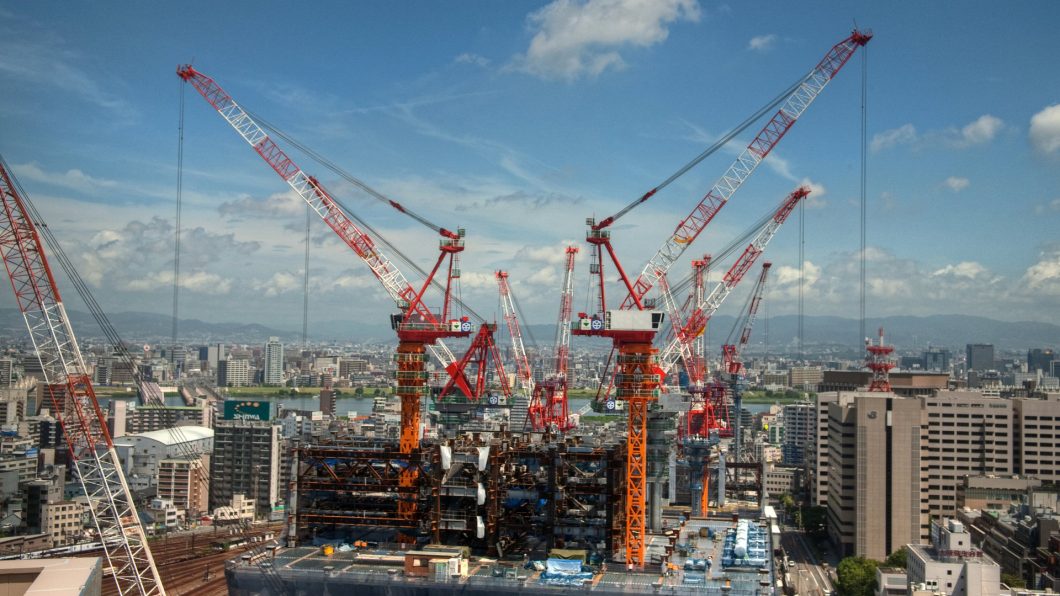Construction is always changing, which is why it’s worth keeping up with important statistics and developments across the industry. In addition to helping you benchmark your performance against your peers, equipping yourself with the latest industry stats can help shape your overall strategy.
Like many other regions, APAC construction firms are also grappling with issues like labor skill gaps and rising supply costs. There’s also plenty of good news: infrastructure investments are pouring in, sustainability continues to be a focus, and digital technologies are helping firms be more efficient.
Below, you can take a closer look at over 40 APAC construction stats to discover insights and trends relevant to AEC today.
You'll learn about:
- The current state of construction in APAC
- The biggest opportunities for growth
- The top challenges that AEC firms must overcome
Jump to statistics by topic:
General Outlook
Operational Challenges and Trends
Environmental and Social Responsibility
Workforce Statistics
Rise of Technology
State of the Industry
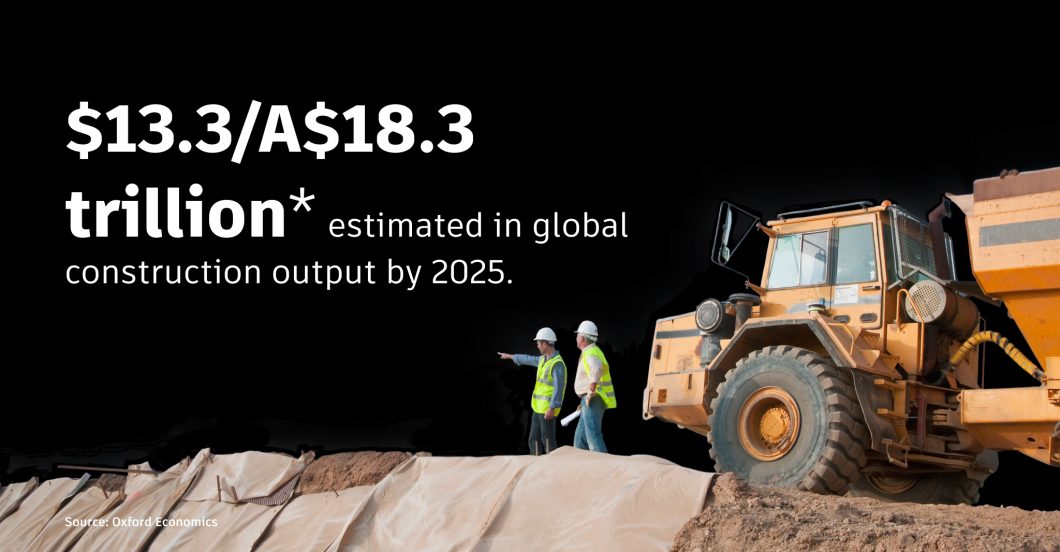
- US$13.3/A$18.3* trillion estimated in global construction output by 2025. [Oxford Economics]
- Spending on construction accounted for 13% of the global GDP in 2020; it’s expected to reach over 13.5% in 2030. [Oxford Economics]
- Asia-Pacific is projected to account for US$7.4/A$10.2 trillion of global construction output by 2030. [Oxford Economics]
- The Australian construction industry experienced a contraction of 2.3% when COVID-19 first hit. [Linesight]
- The Australian construction sector is projected to have an average annual growth of 3.4% from 2022 to 2025. [Yahoo!]
Bouncing back
- Thirty-one percent of construction companies in APIJ are starting to see their revenues returning and are investing more in technology to speed up recovery. [IDC + Autodesk]
- Nineteen percent of APIJ construction firms have adapted to the next normal and have seen more stability in their business. These are the companies that have made pre-pandemic investments in digital technologies, which allowed them to be the most adaptable. [IDC + Autodesk]
- APAC projects in the pre-planning stage account for US$92.3/A$126.9 billion of pipeline value. Meanwhile, projects in the planning stage account for US$443/A$609 billion of pipeline value. [Cision]
- In 2022, APAC construction experts expect growth in private residential, commercial, and infrastructure to be up 12%, 15%, and 50% respectively. [RICS]
Growth in infrastructure, data centers, and smart cities
- Sixty-six percent of investors plan to invest in Australian infrastructure in 2022. Meanwhile, 60% intend to invest in Singaporean infrastructure. [White & Case]
- US$14/A$19 billion will be invested in hard infrastructure projects in Australia. This includes road and rail projects (US$7.5/A$10.3 billion), upgrades to road safety (US$2/A$2.8 billion), and upgrades to local roads (US$1/A$1.4 billion). [Yahoo!]
- Data center investments in the APAC region increased 35% in 2021. [Global Newswire]
- There are more than 250 data center projects in APAC in 2021 that are expected to be operational by 2024. [Global Newswire]
- In 2021, it was forecasted that spending on APAC smart cities would amount to US$45.3 billion. [Statista]
- APAC is expected to account for 40% of market growth for smart city projects. [UBS]
- APAC’s smart city market is expected to reach US$800/A$1100 billion by 2025. [UBS]
Workflows, visibility, and productivity challenges
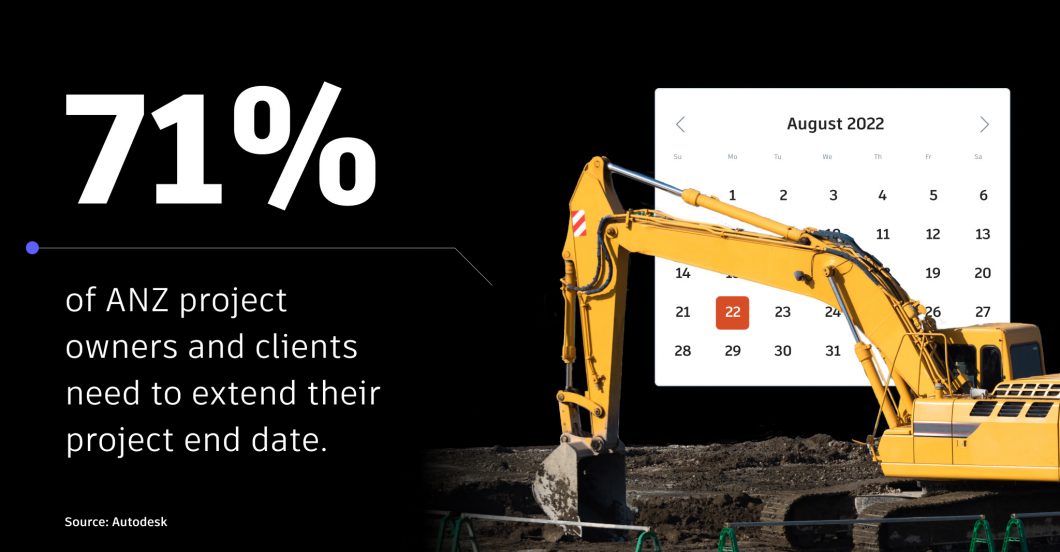
- 71% of ANZ project owners and clients need to extend their project end date. [Autodesk]
- In ANZ, 46% of head contractors capture errors, omissions, and constructability issues frequently, while only 24% of subcontractors do so. [Autodesk]
- Of the head contractors who capture issues frequently, about half regularly compare issues to past projects, while just 27% of subcontractors reported doing so. [Autodesk]
- Capturing data errors in tender documents is a challenge, with 48% of ANZ head contractors and subcontractors reporting that it is difficult or very difficult to do. [Autodesk]
- In ANZ, 80% of project owners and clients take on added costs due to overtime and scheduling issues. Eighty-seven percent have had to extend the project end date. [Autodesk]
- Eighty-six percent of ANZ head contractors and 71% of subcontractors report that coordination and communication issues contribute to lower productivity in their teams. [Autodesk]
Rising costs and supply chain concerns
- APAC construction experts say that the top factors holding the industry back are high material costs (78% of survey respondents), financial constraints (72%), and decreased demand (68%). [RICS]
- Costs related to construction and materials are projected to rise 6% and 7% respectively. [RICS]
- However, an increase in demand for supplementary cementitious materials is rising in APAC. Forty-nine percent of the market’s growth will come from the APAC region. This is driven by the increasing demand for infrastructure, warehouses, and industrial buildings. [Cision]
- The need to analyze manufacturing data is increasing. The manufacturing analytics market is expected to grow 20% through 2027. [Graphical Research]
Sustainability
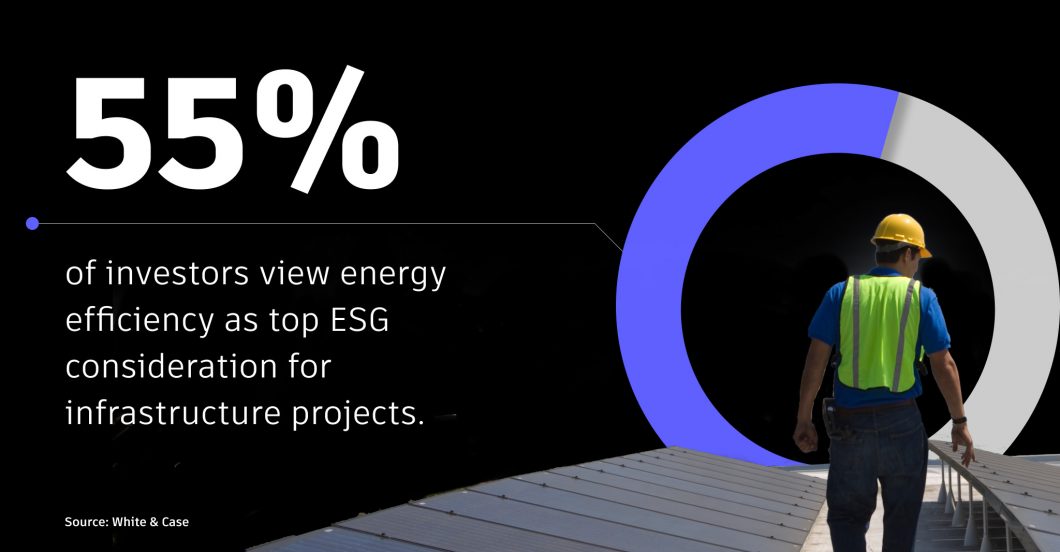
- 55% of investors view energy efficiency as top ESG consideration for infrastructure projects. [White & Case]
- While buildings consume 40% of energy in most countries, structures in Asian metropolitan areas like Singapore and Hong Kong consume up 90% of national electricity. [Equinix]
- Singapore is the only country that has reached two out of five UN Sustainable Development Goals impacted by the AEC industry. [Autodesk]
- The APAC green building market has captured more than 24% of the global market. [Global Newswire]
- The green building market is expected to have a CAGR of 10% by 2023, thanks to favorable government policies. [Global Newswire]
Social responsibility
- Seventy-four percent of investors consider Environmental, Social, and Governance factors when deciding to invest in APAC infrastructure projects. [White & Case]
- Forty percent of investors see labor standards as one of the most important ESG considerations when it comes to infrastructure projects. [White & Case]
- Twenty-eight percent of investors view human rights and community relations as some of the top ESG considerations in infrastructure projects. [White & Case]
Adjusting to the next normal
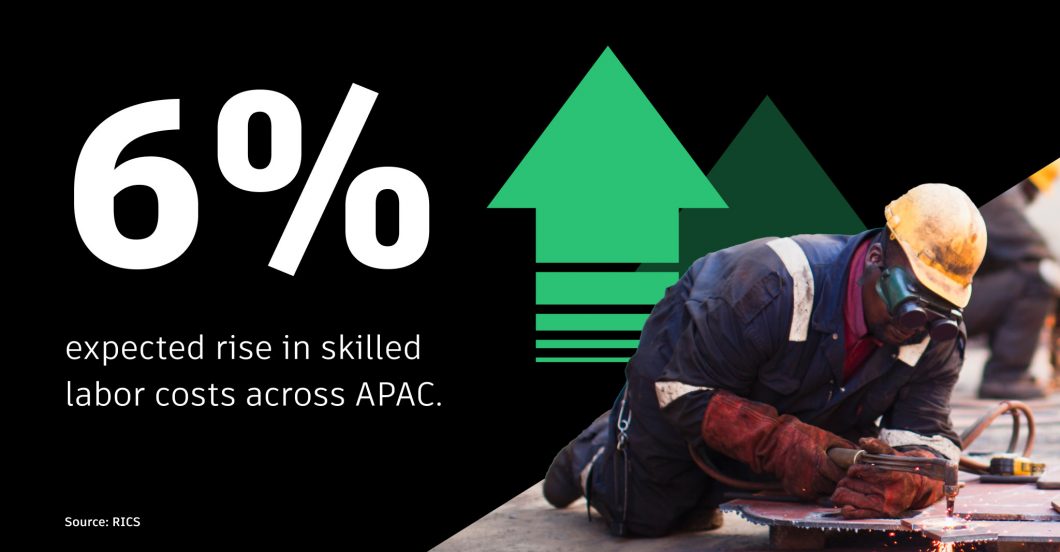
- 6% expected rise in skilled labor costs across APAC. [RICS]
- Pre-pandemic, 23% of APIJ construction professionals worked from home. This increased to 43% in 2021. [IDC + Autodesk]
- Fifty percent of APIJ construction firms saw improvements in health and safety after switching to a hybrid workforce. Meanwhile, 43% and 41% saw better staff retention and an improved employee experience, respectively. [IDC + Autodesk]
- In India, new hires in the Property & Construction sector can expect an average salary increase of 11% [Michael Page]
Shifting demands and skills shortages
- In APAC, construction is #1 on the list of industries most likely to be affected by automation, because of the sector’s high proportion of routine and manual tasks. [Deloitte + Autodesk]
- Demand for tech-savvy and skilled construction employees is increasing, and APAC is experiencing a shortage. Sixty-nine percent of APAC data center operators indicate that they will rely more heavily on cloud and managed services due to the sector's shortage of skilled workers. [HR World]
- In Singapore, 59% of workers are planning to find a new job in the next 12 months, with 71% of millennials saying they intend to search for a new role throughout 2022. [Tech Wire Asia]
- 64% of the world’s industrial robots are found in APAC. [Deloitte + Autodesk]
- In APAC, revenue from AI platforms is forecast to grow twice as fast as the world, from 2019 to 2024. [Deloitte + Autodesk]
- Forty percent of construction firms in Japan have taken a long-term approach to digital transformation. [IDC + Autodesk]
- The top tech investments made by APIJ firms are video conferencing solutions (35%), employee health and security apps (32%), and employee engagement solutions (31%). [IDC + Autodesk]
The importance of data
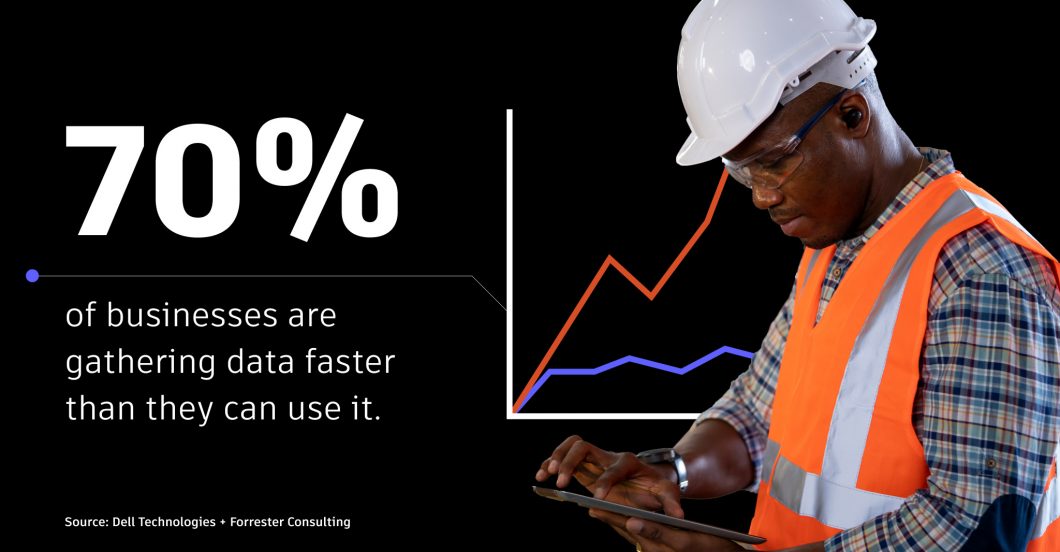
- 70% of businesses are gathering data faster than they can use it.[Dell Technologies + Forrester Consulting]
- Compared to other regions, APAC companies are more likely to have a formal data strategy. Seventy percent and 62% of Australian and New Zealand respectively, said that they have a data plan or strategy. [FMI + Autodesk]
- Forty-nine percent of APAC construction firms regularly evaluate their data for quality purposes. [FMI + Autodesk]
- Sixty-nine percent of APIJ firms cite poor data leadership and lack of support as a challenge when implementing analytics initiatives. [Tech Wire Asia]
- Despite these difficulties, implementing a solid data strategy pays off. Across multiple industries, APAC companies with strong analytics expertise outperform their peers in areas like cost reduction (56%) and business innovation (28%). [Computer Weekly]
*currency conversions (USD to AUD, SGD) provided by XE on 23 Feb 2022
Get more insights into the industry
As these 40+ statistics have demonstrated, the industry will continue to develop as the "next normal" evolves. It’s a great time for construction firms to tap into that momentum and reap the benefits of taking a more strategic approach to data. To begin, download the free e-book Connected Construction: A Better Way to Build Together.
Download NOW


